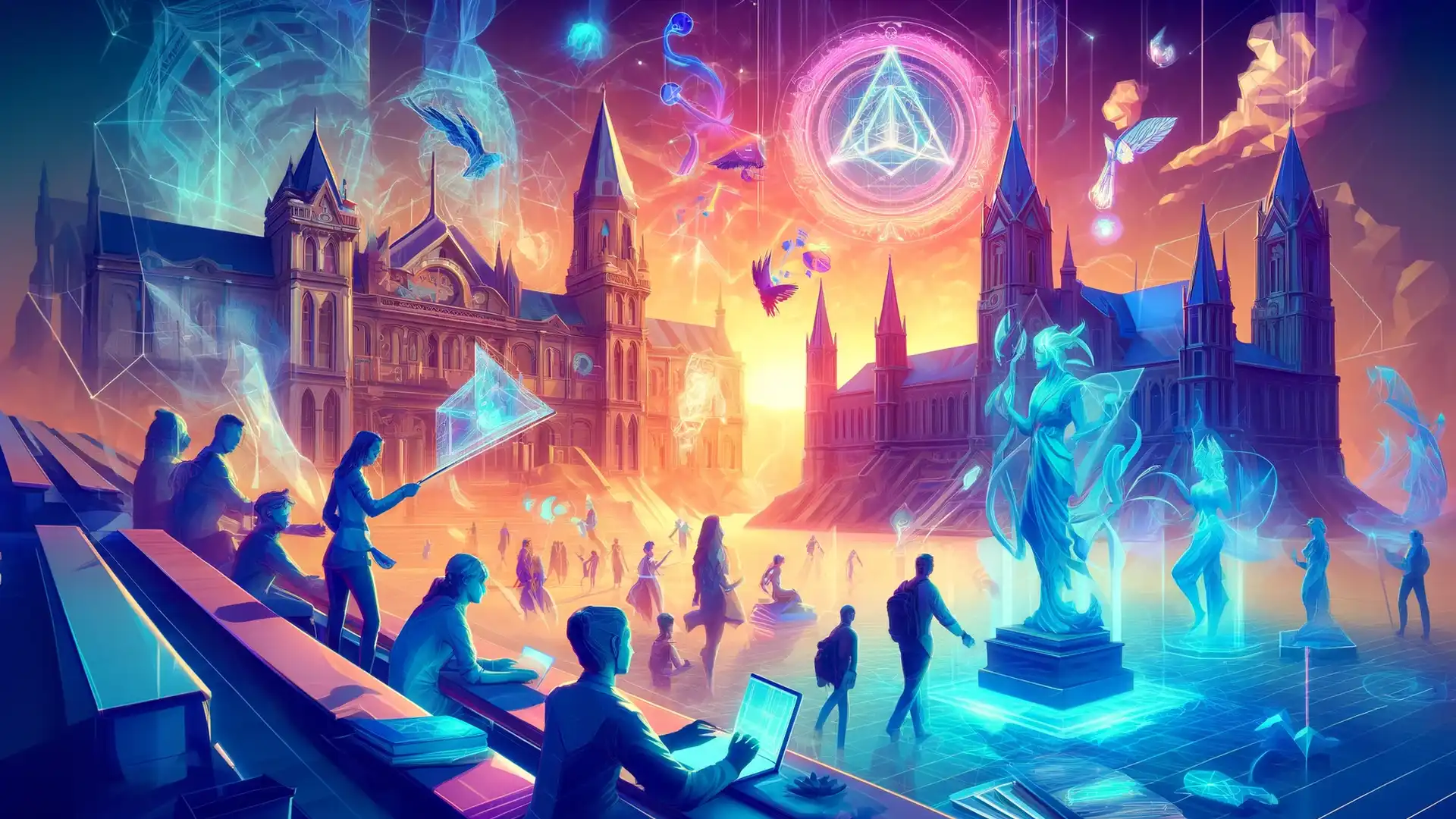Integrating NFTs into Educational Platforms and LMS Systems

 Author:
Artem Grigoriev
Author:
Artem Grigoriev
Revolutionizing Education: NFTs and Learning Management Systems
Envision a classroom where both learning outcomes and student achievements are digitized . This leads to a dynamic and interactive learning environment. This evolution stems from the innovative combination of non-fungible tokens (NFTs) (unique digital assets that establish ownership of a specific item or achievement) with learning management systems (LMS) (software applications designed for documenting, tracking, reporting, and delivering educational courses or training programs). This union stands at the cutting edge of educational technology. It promises to make learning more engaging, personalized, and verifiable.
📘 This article complements: "The Complete Guide to NFT Credentials". Explore it to find answers to all your questions;)
This chapter delves into what NFTs are—unique digital assets that confirm ownership. It explores their seamless integration into educational platforms , aiming to systematically revolutionize the delivery and recognition of educational content. Studies convincingly show that incorporating technologies like NFTs can boost student engagement and retention significantly. This improvement is supported by research from EdTech Review .
Supported by blockchain technology (a decentralized system that records data across multiple computers simultaneously, making it nearly impossible to alter the recorded information), NFTs introduce a new dimension of robust security and unmatched transparency in educational transactions. This positions the blockchain as an ideal platform for NFTs. Every digital badge, diploma, or piece of educational content becomes uniquely secure and tamper-proof. Thus, credentials issued through NFTs are easily verifiable and impossible to forge , effectively addressing common concerns about the authenticity of educational qualifications. According to a detailed report by the World Economic Forum , blockchain technology could potentially prevent fraud in educational and professional credentials, providing a more reliable method of verification.
Furthermore, NFTs can significantly enhance student engagement by offering tokenized rewards and certifications. Imagine students earning digital tokens as they complete courses. They could then use these tokens to access additional courses or exchange them for other valuable educational materials. This gamification of education not only motivates learners but also introduces new ways for them to interact with educational content. It is proven to enhance student motivation and participation, making learning a more rewarding and fulfilling experience. Additionally, this system could provide insights into student preferences and achievements , further tailoring the educational approach to meet individual needs.
The integration of NFTs within LMS could lead to a vibrant new marketplace for educational content. Here, students might potentially buy, sell, or trade their course materials as NFTs. This promotes a more dynamic and student-driven learning ecosystem and could radically alter how knowledge and educational resources are distributed and consumed, making education more accessible and tailored to individual learning preferences. The creation of a decentralized educational marketplace not only democratizes access to learning resources but also fosters a participatory approach to education.
💡 Note: NFTs facilitate a more secure, transparent, and engaging educational experience by integrating the robust features of blockchain technology with traditional learning systems.

However, integrating NFTs into LMS is not without its challenges. Issues such as scalability, the environmental impact of blockchain technologies, and the need for regulatory compliance must be addressed. Strategies to overcome these obstacles include adopting more energy-efficient blockchain protocols and developing legal frameworks that support the use of digital tokens while ensuring user data protection. Effective solutions involve the use of Proof of Stake (PoS) blockchain protocols, which are more energy-efficient than traditional Proof of Work (PoW) systems. Furthermore, the adaptation of blockchain technology in education must consider student privacy and data security, aligning with global data protection regulations.
Looking ahead, the potential integration of AI (artificial intelligence) and machine learning with NFT-based educational systems could further personalize learning. These technologies could automate the issuance and management of educational NFTs, adapting learning paths based on student performance and preferences. This makes education even more responsive to individual needs. An insightful analysis by the Harvard Business Review discusses how these advanced technologies could revolutionize educational methodologies and student interaction. The integration of AI could also aid in optimizing the distribution of educational resources, ensuring that they are accessible to a broader range of students across different backgrounds and abilities.
This chapter sets the stage for a deeper discussion on the practical application of NFTs in education. It presents a vision where learning management systems not only manage and deliver educational content but also provide a platform for secure, verified, and engaging educational achievements.
💡 Tip: Educators and institutions looking to implement NFTs should consider both the technological infrastructure required and the pedagogical implications to ensure that these digital assets enhance rather than complicate the learning experience. Thoughtful implementation of NFTs in educational settings aims to enhance educational outcomes and fosters a more engaging, inclusive, and effective learning environment.

Navigating the Challenges: Practical Insights and Future Visions
As we delve into the potential of non-fungible tokens (NFTs) in education, addressing the associated challenges is crucial. This chapter explores key issues such as intellectual property concerns, technological barriers related to blockchain security, and the overarching need for transparency. Enlightening case studies from institutions that have successfully leveraged NFTs are also presented. These studies illuminate aspects such as digital ownership, rights management, and student engagement. For instance, renowned institutions like MIT have been at the forefront of using blockchain to issue verifiable digital credentials. They showcase the practical applications and advantages of this technology in education. MIT's Blockchain Initiative exemplifies how blockchain's secure, transparent nature can enhance the credibility and global accessibility of academic credentials .
A significant challenge in this domain is intellectual property (IP) , encompassing the legal rights creators hold over their works. As educational materials begin to be tokenized, navigating licensing and copyright issues becomes more complex. Smart contracts, a fundamental component of blockchain technology, present a promising solution. They automate the enforcement of IP rights and the distribution of royalties. This helps creators and educational entities maintain control over their content. This innovative approach to IP issues is supported by case studies, such as the University of Nicosia, which utilized blockchain for copyright management in digital education resources. The deployment of smart contracts clarifies ownership and usage rights, establishing a clear framework for managing intellectual property within the educational sector.
Furthermore, the security and privacy of transactions on educational platforms are paramount. Advanced cryptographic techniques are vital to enhancing both the security and privacy of these transactions. This not only preserves the integrity of the blockchain but also protects sensitive student data. It ensures compliance with stringent regulations such as the GDPR. The importance of security in blockchain for educational applications is underscored by research from top cybersecurity firms. These highlight the resilience of blockchain against common cyber threats. Blockchain Security Advances illustrate how blockchain's inherent features, such as decentralization and encryption, contribute to robust security measures. These are essential for protecting academic data and preventing unauthorized access .
💡 Note: Smart contracts play a pivotal role in maintaining intellectual property rights in the tokenization of educational materials. They automate the enforcement and distribution of royalties, safeguarding the interests of creators and institutions.

This chapter also details examples from pioneering institutions that have integrated NFTs within their systems. These case studies demonstrate how NFTs can enhance student motivation by providing tangible rewards and recognitions for academic achievements. These are easily accessible and verifiable worldwide. They highlight the potential of NFTs to revolutionize student engagement and academic recognition, offering students a modern and innovative way to be recognized for their efforts.
Looking ahead, the potential integration of virtual reality (VR) and augmented reality (AR) with NFTs offers an exciting opportunity. This integration can create immersive educational experiences that are more engaging and interactive. These technologies give students novel ways to explore complex subjects. However, this futuristic vision must also address ethical considerations, particularly ensuring equitable access and working to minimize the digital divide. Visionary projects that combine AR/VR with blockchain are currently being tested in several universities. They enhance the learning process by creating highly interactive and engaging digital environments. This combination promises to introduce a new dimension to learning, making abstract concepts tangible and experiential.
The evolving legislative landscape presents both opportunities and challenges for the adoption of NFTs in education. The chapter encourages ongoing dialogue among educators, technologists, policymakers, and the broader community. This dialogue is crucial for maximizing the benefits of NFTs in education and minimizing the risks associated with technology adoption.
Through comprehensive analysis and forward-looking insights, this chapter not only addresses the immediate challenges of integrating NFTs into educational systems but also sets the stage for future innovations. These innovations could continue to transform the landscape of educational technology.
💡 Tip: For institutions considering NFT integration, engaging in continuous dialogue with legal, technological, and educational experts is essential. This dialogue helps navigate the complex landscape of digital rights management. It ensures that the deployment of NFTs in education adheres to current legal standards and ethical norms. Additionally, it fully realizes their potential to enhance the educational experience.

Securing NFT Credentials: Best Practices for Enhanced Safety
Decentralized Identity Verification Through NFT Credentials: What It Is and How It Works
Is Using NFT Credentials Legal? Legal Aspects and Privacy Concerns
Intellectual Property Rights and NFT Credentials
Ethical Considerations in Using NFTs for Educational Credentials
